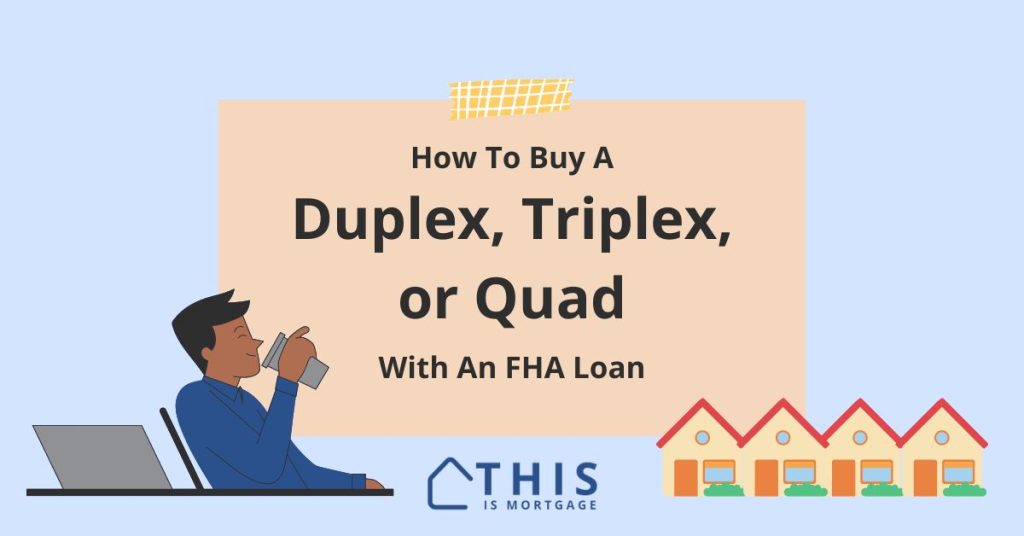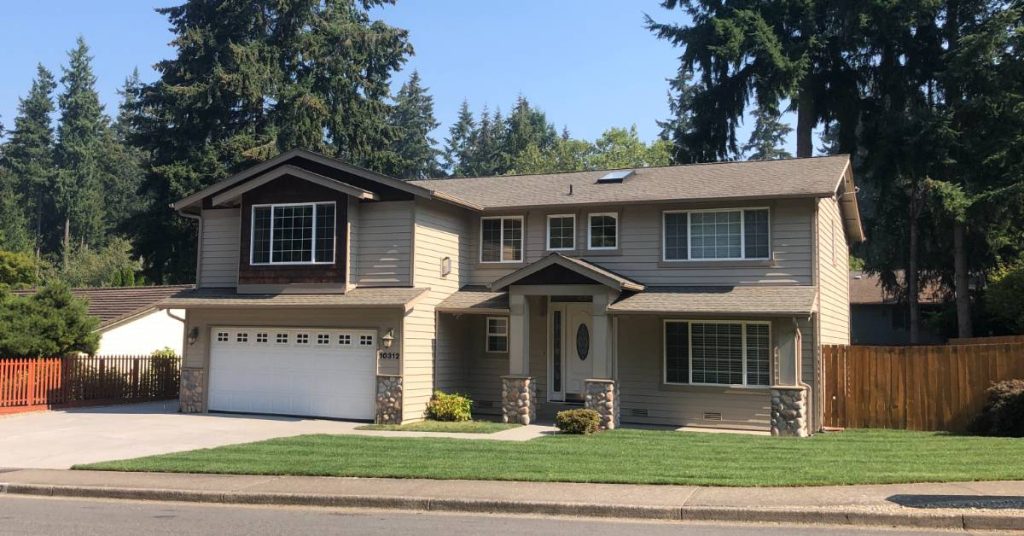Many people wonder if they can use an FHA loan to get their feet wet as a landlord, earn rental income, reduce primary residence expenses, and start investing in real estate.
The answer is a resounding “yes.”
FHA loans allow you to buy a duplex, triplex, or four-plex (2-4 unit) property as long as you live in one unit. You can rent out the remaining units.
And for the most part, the same FHA lending rules apply for multi-unit properties as for single-family residences.
Ready to become a homeowner and investor at the same time? Here’s how.
Speak to a lender to see if you qualify for an FHA multifamily mortgage.
In this article:
- FHA duplex loan process
- Pros and cons of buying a multifamily
- General FHA guidelines
- Using rental income to qualify
- FHA self-sufficiency test for 3-4 units
- FHA multi-unit loan limits
- Is it a legal unit?
Buying a Duplex, Triplex, or Fourplex with FHA
Buying a multifamily property is similar to buying any other property with some additional steps.
- Get pre-approved by an FHA lender
- Hire a realtor experienced in multifamily homes
- Find a duplex, triplex, or fourplex in your price range
- For a triplex or fourplex, conduct the FHA self-sufficiency test
- Ensure there’s strong demand for rentals in the area
- Make an offer
- Depending on the market, ask for a seller credit for closing cost assistance
- Receive an accepted offer
- Request lease agreements from the seller
- Send the purchase contract and lease agreements to the lender
- The lender orders an appraisal including market rent estimates
- Your file is sent to underwriting
- Supply additional requested items, called “conditions”
- Receive final approval
- Sign closing docs
- Get the keys, move in, and rent out any non-rented units
- Get new leases from existing tenants showing you as the landlord
Request a call to see if you qualify for FHA multifamily.
Advantages of buying a duplex versus single-family
Buying a duplex or other multi-unit home comes with clear advantages. You essentially buy a home – even your first home – and have a tenant help you pay your mortgage.
This potentially reduces your monthly cost, even though the duplex often comes with a higher purchase price.
| FHA Single Family | FHA Duplex | |
| Upfront Costs | ||
| Home price | $400,000 | $550,000 |
| Down payment | $14,000 | $19,250 |
| Closing costs | $8,000 | $9,000 |
| Total upfront cost | $22,000 | $28,250 |
| Monthly Costs | ||
| Principal/Interest payment | $2,377 | $3,267 |
| Mortgage insurance | $278 | $383 |
| Taxes/Insurance | $380 | $500 |
| Rental income | -$0 | -$1,800 |
| Total monthly cost | $3,035 | $2,350 |
You also become a homeowner and a real estate investor with one home purchase. After one year, you can move out of the home and rent out both units, amplifying your investing efforts.
You can also set yourself up for future cash flow. It is more difficult to turn a profit each month renting out a single-family home. A duplex can often churn out a lot more income versus your payment. And when you’re looking at a triplex or fourplex, it’s even more realistic. Plus, when you rent out the whole property someday, you have more than one tenant to help pay the mortgage.
But why FHA? FHA is the only loan program that lets you
- Buy a duplex, triplex, or fourplex with 3.5% down
- Get a low down payment with no income limits
- Count future rental income with no landlord experience
- Build landlord history , which is needed to use rental income from the property to qualify for the next property
- Do all this with a 580+ credit score
Connect with a loan officer to see if you can buy a duplex with FHA.
Disadvantages of buying a duplex
Buying a 2-, 3-, or 4-unit property comes with drawbacks as well.
- Higher upfront cost: You’ll need a bigger down payment and more for closing costs to buy a multifamily home
- Payment risk: If you can’t rent one unit, you’ll pay more each month without supplemental rental income
- Liability: Whenever you rent real estate to someone, you are at greater risk of lawsuits
- Landlord learning curve: There’s a lot to learn, from maintenance to tenant laws to screening. Learn as much as you can prior to purchasing a duplex
- Harder to sell: It could be harder to sell someday, especially in a down market. Not as many people are looking to buy a duplex as a single-family residence
As with anything worthwhile, there are greater costs and risks. But in a few years, you’ll be glad you took on some extra work and risk.
Related: Multifamily vs Single-Family FHA Calculator
Is buying a duplex a good idea?
Buying a duplex is a highly personal decision. Make an honest assessment of yourself and your goals to make the right choice.
Here are good reasons to buy a duplex:
- You’re serious about owning rental properties
- You have a steady income stream outside of rental income
- You can afford the full payment if you have to
- You’re in it for the long run
- You want to set yourself up for financial independence one day
Bad reasons to buy a duplex:
- People on social media make it look glamourous
- Your friend did it
- You want to impress people
If you buy a duplex for a “bad reason,” you won’t stick it out in tough times. You’ll lose a lot of money.
FHA duplex, triplex & fourplex guidelines
Here are the criteria you’ll need to meet to qualify for any FHA loan including for a multifamily property.
| Credit Score | 580+ |
| Down payment | 3.5% |
| Loan-to-value (LTV) | 96.5% |
| Mortgage insurance | 1.75% upfront, 0.55% per year |
| Occupancy | Live in one unit |
| First-time buyer | Not required |
| Debt-to-income ratio | Below 56.9% |
| Property type | 1-4 legal units |
| Max loan limits | $637k-$2.2M+ based on # of units and location |
| Income limit | None |
| Property condition | Must meet HUD quality guidelines |
FHA multifamily mortgage insurance
For all FHA loans, you must pay a mortgage insurance premium, otherwise known as FHA MIP. This insurance comes in two forms, both of which must be paid.
Upfront MIP: 1.75% of the loan amount, or $1,750 for each $100,000 borrowed. This can be wrapped into the loan, above and beyond the 96.5% maximum LTV.
Annual MIP: Though it’s called “annual”, you pay it monthly, in 1/12 installments. Recently, FHA reduced its annual MIP, which should help many multifamily buyers. For down payments less than 5%, and loan amounts less than $726,200, the annual MIP is 0.55%, or $46 per month for each $100,000 in loan amount.
Start your multifamily home purchase. Speak to a lender.
Where can the down payment come from?
The down payment of 3.5% can come from a variety of sources.
- Checking and savings accounts
- Cash on hand (you must deposit it into a financial institution and provide a letter of explanation about how you accumulated funds)
- Retirement accounts
- Liquidated stocks and bonds
- Gift funds from relatives
- Private Savings Clubs
The down payment may not come from an interested party, such as the seller, lender, Realtor, or builder.
Using rental income to qualify – 2024 guidelines
Perhaps the biggest benefit to buying a multi-unit home is that you can use future proposed rent to qualify.
Yes, you can use rental income you are not receiving yet. You do not need landlord experience like some other programs. FHA assumes you can rent the units, based on 75% of either the current market rent (if vacant) or 75% of actual rent (if currently rented).
| Example: FHA Duplex Rental Income | |
| Duplex price | $400,000 |
| Total payment | $3,000 |
| Income needed to qualify | $7,500/mo |
| Employment income | $6,500/mo |
| Result | Does not qualify |
| Rental income on 1 unit | $1,800 |
| Rental income after 75% vacancy factor | $1,350 |
| New total qualifying income (wages + rental income) | $7,850 |
| Result | May qualify |
In this example, rental income may have pushed this applicant from “denied” to “approved.” This is the power of buying a 2-, 3-, or 4-unit home with FHA.
Speak to a lender to start your multifamily home purchase.
How much rental income can I use to qualify?
Since this is a home you’re buying, you may not have any rental history for the property except perhaps current leases.
If you have leases, provide them to the lender. You can use these to prove future rent.
If not, the lender will order a comparable rent schedule along with the property appraisal. The appraiser will provide market rent estimates for each unit.
You can use the lesser of:
- Income based on a profit and loss statement supplied by the appraiser (Fannie Mae Form 216 or Freddie Mac Form 998); or
- 75% of the fair market rents (Fannie Mae 1025/Freddie Mac 72) or actual rents, whichever is lower.
For example, if the appraiser says a unit could rent for $1,000 per month. But it’s currently rented at $800. You can use 75% of $800 to qualify, equaling $600.
Related: FHA Rental Income Guidelines: Use Future Rent to Qualify.
FHA self-sufficiency test for 3- and 4-unit properties
FHA recently imposed an additional rule for properties with 3-4 units called the FHA self-sufficiency test. Fortunately, this guideline does not apply to duplexes.
But if you’re shopping for a 3- or 4-unit home and plan to use FHA, make sure it will pass the test before making an offer.
In short, the FHA self-sufficiency test determines whether rent from all units will cover the full payment.
→Run this FHA self-sufficiency test calculator if you’re considering a 3 or 4-unit property.
Does FHA require financial reserves on a duplex?
Reserves are leftover assets after closing to cover emergencies. Reserves are not required when using FHA for a duplex or single-family home. While they are not required, they can help you get approved. You can supply proof of reserves to more easily qualify for the loan.
However, for 3-4 unit properties, you must have cash reserves after the down payment and closing costs equal to three months of the full payment. For example, if your total principal, interest, mortgage insurance (MIP), property tax, property insurance, and HOA dues were $2,000 per month, you would need $6,000 after paying the down payment and closing costs.
Related: FHA Multifamily Reserve Requirements
| Cost | Amount |
|---|---|
| 3- or 4-unit home price | $300,000 |
| Down payment (3.5%) | $10,500 |
| Closing costs | $7,000 |
| Principal, interest, MIP, tax, insurance, HOA payment | $2,000 |
| Reserves needed after closing | $6,000 |
| Total needed (down payment, closing costs, reserves) | $23,500 |
Financial reserves can be in the form of assets that can be liquidated if needed. Reserves can’t come from a gift or credits from the lender, seller, or other interested parties. However, you can use seller credits to pay for closing costs so that you have more reserves after closing.
FHA duplex loan limits
FHA offers higher loan limits when buying a 2-4 unit property. The reason is that multi-unit homes usually cost more than single-family residences.
For 2024, FHA loan limits are as follows.
| Units | Standard areas | High-cost area max |
| 1-unit | $498,257 | $1,149,825 |
| 2-unit | $637,950 | $1,472,250 |
| 3-unit | $771,125 | $1,779,525 |
| 4-unit | $958,350 | $2,211,600 |
Many areas have limits between the low and high numbers listed above. Also, Alaska and Hawaii offer even higher limits of roughly $2.2 million to $3.3 million for 2-4 unit properties. To check your exact limit, use HUD’s FHA loan limit lookup.
What is a legal property unit?
Be careful when searching for a duplex, triplex, or fourplex.
Sometimes, the owner creates an “unofficial” additional unit. They might install a sink and a bathroom in the basement and try to sell the home as a duplex.
A true multi-unit should have the following characteristics:
- If a single-family residence was converted, ensure proper permits were obtained
- The county shows the property as a multi-unit in public records
- Each unit has its own utility meters
- Each unit has its own entrance accessible without going through the other unit
- Zoning allows for multi-unit homes
Ideally, the home was built from the ground up as a multi-unit. These homes typically have great layouts and equally distributed square footage.
Conversions, though, often have strange entrances and floorplans that could be harder to rent. However, multi-units that were once single-family homes are quite common in densely populated urban areas. As long as all the units were legally converted and the home is typical for the area, owning one of these properties should not be a problem.
FHA will not allow you to qualify with rental income on a legal 1-unit property. That’s essentially trying to use roommate or boarder income, which FHA does not allow. However, some programs like Freddie Mac Home Possible allow roommate income, so consider non-FHA options for a “multifamily” that’s really a 1-unit home.
Connect with a lender to see if you qualify for a multifamily home purchase.
Other ways to finance a multifamily property
Conventional loan: You can also house hack using a conventional loan. A new rule that went into effect in November 2023 allows you to put just 5% down and comes with no self-sufficiency test.
VA loan: This is likely the best way to get into investing because you can buy a home up to 4 units with zero down. It’s only available to those with current or former eligible U.S. military service.
Non-QM: These are specialty loans that are outside of traditional lending standards. Because they require large down payments and come with prepayment penalties and other “gotchas”, they are for savvy investors, not newer house-hacking buyers.
Seller financing: In rare cases, the seller may be able to “carry the loan.” This means they agree to become the mortgage holder and you make payments to them. If you find a property that no one else wants, you may be able to convince the seller to become your lender.
FHA loan duplex, triplex, and four-plex FAQ
Buying a duplex is harder in some ways and easier in others. It will probably cost more. You’ll need to verify rental income. It could be harder to find a duplex to buy as well. However, it’s easier because you can use rental income to qualify and loan limits are higher for 2-, 3-, and 4-unit properties.
You’ll have a larger monthly payment, so if you don’t rent one unit, it could strain your budget. You’ll also need to know state and local tenant laws or hire a property management company to avoid lawsuits. Because the rewards are greater when buying a duplex, so are the risks.
Conventional, VA, and FHA loans allow you to buy 2-4 unit properties. For VA and FHA, you must live in one unit. Most conventional loans allow you to live in one unit or buy it as an investment property and rent all units. The conventional loan down payment is 5% compared to 3.5% for FHA and 0% for VA.
Yes. FHA allows loans on 1-4 unit properties. A triplex is a fantastic use of a 3.5%-down FHA loan.
This likely refers to a 4-unit (fourplex or quad) financed with FHA. Homes up to 4 units are considered residential and can be financed with a regular FHA loan, even for first-time buyers.
Start your real estate investment journey with FHA
FHA could be the best way to start as a real estate investor. With just 3.5% down and low rates, it sure beats buying a separate rental property.
And, you could have an easier time qualifying thanks to the rental income.
Contact a lender and take the first step by getting pre-qualified for an FHA multi-family loan.
Request a call to discuss your FHA multi-unit home purchase.




